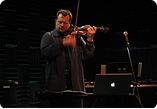Todd Reynolds: String Theory
For all the extreme tinkering that goes on with drum machines and synths these days, it's a welcome blast of fresh air to come across a musician who is more concerned with testing the possibilities of acoustic instruments in a signal-processed setting. Composer and producer Todd Reynolds has made a career out of amplifying, bending, stretching and morphing the pristine sounds of the violin into strange new textures — first as a longtime member of Bang on a Can and the Steve Reich ensemble, and in countless commissioning and recording projects centering around the New York pop and avant-garde communities and his own concert-theater events.
Reynolds also co-founded the progressive string ensemble Ethel, and for a spate of several genre-busting years found himself recording and touring with a range of artists that includes John Cale, Tan Dun, cellist Yo-Yo Ma and, in 2005, a legendary double bill with Todd Rundgren and Joe Jackson. Since then, Reynolds has continued to perform with such artists as indie ubergeeks The Books and oud master Dhafer Youssef. When he's not on the road or in the studio, he's busy teaching others about the possibilities of Ableton Live at various residencies and workshops he conducts throughout the U.S.
"Every time I go out and teach, which is often, I do a Live demo," he says. "With Live, I can show kids all the things that you can do with a sound file from beginning to the end — how you can compose with the program, play live with the program, or how you can even use it as your very basic reverb processor, for example. I just really want these kids to have a chance, and they get it after they spend ten minutes with Live because it's such a user-friendly program."

When did you start working with Ableton Live?
I think it was version 3 — it might have even been earlier. When it first came out, it was just a real liberating feeling to start planning on doing things live. It took me a long time to get to the point of getting away from hardware and into software, and Live quickly became my program of choice — the most versatile thing possible. Now of course, it continues on that trajectory, to where more and more things are possible, to where I barely use anything else. Basically everything I've done over the past five or six years has been inside of Ableton Live.
What are some of the main functions of Live that you rely on?
It's all about the clock for me. The ability to sync VSTs and internal plug-ins — I use the Filter Delay a lot, for instance — and the idea that I can sync that to a tempo, can play sound files along with it, and have those things interact together, that's the main thing I use it for.
How might you start composing a piece of music?
Well, for instance, I'll make some loops that work really well together, and then I'll record them as a Clip into Live. So I've got my tempo established and I've got a bunch of Clips that have been generated through looping, and they'll become part of a sonic environment, and they'll all be clicking along at 92 beats per minute.
At that point, I'll take a Filter Delay and throw that on a return, and then I can send my Clips, my live signal and even my original loops to that delay. I have all these different ways to actually generate material on the fly, and it's all synced, in one tempo, and it's bouncing around the stereo field in a very controlled way. Then when I kick in a sound file or a drum loop or a bass loop or whatever I need to change the overall scenario, it's gonna kick in on a down beat. That level of control is something that I really appreciate having, and the fact that I have it has impacted my composition.

You've said you come from a minimalist tradition of composing.
For 17 years I've worked with Steve Reich, and loved his music for years beforehand, so I feel very connected with that world. It's about the idea that things that repeat also transform as they repeat, if only in the way we hear them, and that repeating is very much akin to a human heartbeat for me. It's what makes pop music work, it's what makes classical music work in some ways, and that type of presence and evolution is just really organic to me, it's the 'motor' which generates the core of the music.
So Live has allowed me to work, and really encouraged me to work, in that area, because the fact that I can loop things and then evolve them in different ways but still lock to a tempo is what I like. And I can have part of my scene hooked up to a clock, and then another part can be very free, running alongside half the time. I call Live my catch-all program. It's essentially the program that does it all, and its routing possibilities, built-in effects, clock and mixer-based easy user-interface have been integral to how I hear, create, distribute and perform my music.
For more about Todd Reynolds and his music, check out www.toddreynolds.com.
Photo Credits: © 2006 Wellington Lee, V. Paul Virtucio, Heidi Stubner